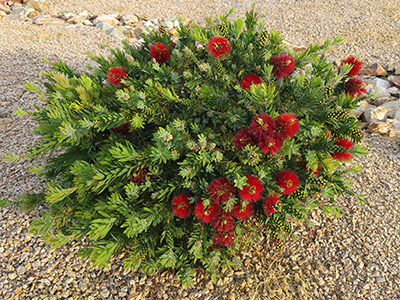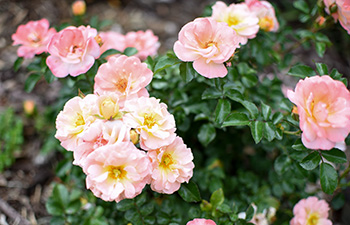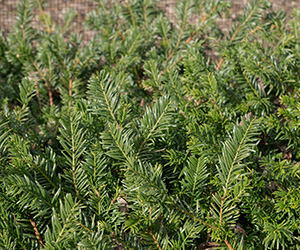Dwarf Shrubs

Dwarf bottlebrush
Don’t have space for your favorite shrub? Or maybe you’re tired of pruning? There may be a dwarf option! Dwarf shrubs have been growing in popularity for their relatively low maintenance needs and ability to fit into the smallest of spaces. Read on to learn about several recommended dwarf shrubs that deliver big interest with a small plant.
Bottlebrush
Although bottlebrush is usually grown as a tree, there are also dwarf varieties that only reach three feet tall. Despite their small form, dwarf bottlebrushes are still bursting with bristly, red flowers that attract hummingbirds and butterflies. Bottlebrush thrives in full sun and tolerates both drought and salt. However, keep in mind that it is less frost tolerant than some other shrub options. Look for the cultivar ‘Little John’ at your local nursery.
Azaleas
If you love azaleas but you’re short on space, don’t fear! Kurume hybrids grow to be three to five feet tall, depending on the variety. The plentiful flowers come in shades of pink, red, purple, or white in the spring. If you need to go even smaller, a true dwarf variety such as ‘Red Ruffle’ may be the best choice. ‘Red Ruffle’ only reaches two to three feet tall, and sports frilly crimson blooms as the name suggests. Azaleas prefer well-drained, acidic soil, and filtered sunlight.
Hollies
Depending on the variety, hollies can be as large as trees or as small as dwarf shrubs. One favorite dwarf variety is ‘Carissa’, which has a height of only three to five feet and spiny leaves. Another option is ‘Bordeaux’, a cultivar of the native yaupon holly that maxes out at two to three feet. Both options are sterile, meaning they won’t produce berries. If that's what you're looking for, then plant ‘Taylor’s Rudolph’ which reaches three to four feet tall and produces red berries. None of these hollies are picky; they will tolerate a wide range of light and soil conditions.
Roses

Dwarf rose
You don’t need a sprawling rose garden to grow these popular flowers. Miniature roses only grow to be eight to 24 inches tall and produce flowers that are the size of a dime or quarter. Although tiny, the blooms come in almost every color of the rainbow. Miniature roses need plenty of light, so they should be planted outdoors. Plant them in a rich, well-drained potting media in a container or add them to a mixed border.
Walter’s Viburnum
Walter’s viburnum is prized for the texture it adds to the landscape and the show of tiny white flowers it produces in the spring. Fortunately, there are several dwarf varieties to choose from in case you don’t have the space for even a small tree. The ‘Densa’ cultivar only reaches two feet tall and does not disappoint with its prolific flowering. Other popular varieties to look for at your local native nursery include ‘Mrs. Schiller’s Delight’ and ‘Walters’ Whorled Class’. They tolerate a variety of soil types and should be planted in full sun to partial shade.
Japanese Plum Yew

Dwarf Japanese plum yew
A small and shady yard can make choosing plants tricky, but fortunately Japanese plum yew fits the bill. The evergreen, needle-like leaves make a nice backdrop for other plants year-round. As an added bonus, deer don’t like to eat it. Not all varieties are small, but ‘Prostrata’ only grows to be a few feet tall. Its spreading form makes it a lovely groundcover or foundation planting. Plant dwarf Japanese plum yew in a location with well-drained, slightly acidic soil. Although it can grow as far south as zone 9B, it prefers cooler areas.
If you have any questions as you establish dwarf shrubs in your landscape, don’t hesitate to contact the experts at your county Extension office.
Also on Gardening Solutions
- Azaleas
- Bottlebrush
- Dwarf Hollies
- Japanese Plum Yew
- Roses
- Walter's Viburnum and Other Viburnum Species

